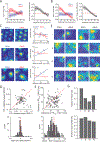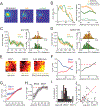Remembered reward locations restructure entorhinal spatial maps
- PMID: 30923222
- PMCID: PMC6516752
- DOI: 10.1126/science.aav5297
Remembered reward locations restructure entorhinal spatial maps
Abstract
Ethologically relevant navigational strategies often incorporate remembered reward locations. Although neurons in the medial entorhinal cortex provide a maplike representation of the external spatial world, whether this map integrates information regarding learned reward locations remains unknown. We compared entorhinal coding in rats during a free-foraging task and a spatial memory task. Entorhinal spatial maps restructured to incorporate a learned reward location, which in turn improved positional decoding near this location. This finding indicates that different navigational strategies drive the emergence of discrete entorhinal maps of space and points to a role for entorhinal codes in a diverse range of navigational behaviors.
Copyright © 2019 The Authors, some rights reserved; exclusive licensee American Association for the Advancement of Science. No claim to original U.S. Government Works.
Conflict of interest statement
Figures




Comment in
-
Neural representations across species.Science. 2019 Mar 29;363(6434):1388-1389. doi: 10.1126/science.aaw8829. Science. 2019. PMID: 30923208 No abstract available.
-
Grids cells go for a goal.Nat Rev Neurosci. 2019 Jun;20(6):316-317. doi: 10.1038/s41583-019-0170-0. Nat Rev Neurosci. 2019. PMID: 30992559 No abstract available.
References
-
- O’Keefe J, Dostrovsky J, The hippocampus as a spatial map. Preliminary evidence from unit activity in the freely-moving rat. Brain Res 34, 171–175 (1971). - PubMed
-
- Hafting T, Fyhn M, Molden S, Moser MB, Moser EI, Microstructure of a spatial map in the entorhinal cortex. Nature 436, 801–806 (2005). - PubMed
-
- Kropff E, Carmichael JE, Moser MB, Moser EI, Speed cells in the medial entorhinal cortex. Nature 523, 419–424 (2015). - PubMed
-
- Solstad T, Boccara CN, Kropff E, Moser MB, Moser EI, Representation of geometric borders in the entorhinal cortex. Science 322, 1865–1868 (2008). - PubMed
-
- Sargolini F et al., Conjunctive representation of position, direction, and velocity in entorhinal cortex. Science 312, 758–762 (2006). - PubMed
Publication types
MeSH terms
Grants and funding
LinkOut - more resources
Full Text Sources

